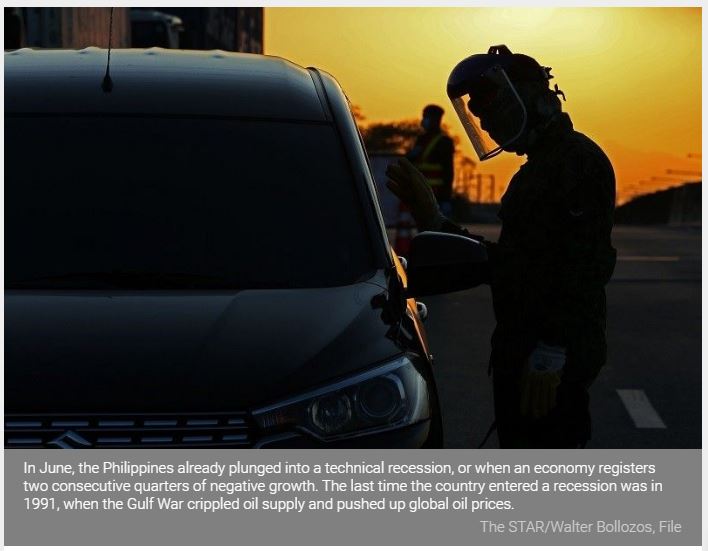Philippines plunges into worst economic slump under democracy
MANILA, Philippines (UPDATE 3 1:03 p.m., Aug. 6) — The Philippines officially entered a recession in the second quarter, an expected economic collapse brought by the pandemic that has gone beyond government control with the country likely to become Southeast Asia’s coronavirus hotspot on Thursday.
Gross domestic product (GDP) plummeted 16.5% year-on-year from April to June, sinking deeper into contraction after a revised 0.7% slump in the first quarter, the Philippine Statistics Authority reported early Thursday.
The deep dive meant that in nominal terms, coronavirus slashed P680 billion from the economy in the second quarter from same period a year ago to value at P8.6 trillion as of end-June. From January to June this year, real GDP dropped 9% year-on-year.
With the latest data, the local economy, once considered a darling of investors in the region, has officially sank into a recession, defined by two succeeding quarters of negative GDP growth. Before this, an economic recession was last recorded from second to third quarter of 1991 when the Gulf war crippled oil supply and pushed up global oil prices.
But the second-quarter contraction alone, which captured the full impact of the Luzon lockdown, was so massive, it marked the biggest nosedive in economic performance under democratic rule. The latest data was the worst since available records dating back 1981.

“The high-frequency data that we track suggest economic activity is recovering much slower than elsewhere. Meanwhile, the government has been unable to cushion the blow,” Alex Holmes, Asia economist at Capital Economics, said in an e-mail ahead of data release.
The depressing trend in the economy is not at all unique to the Philippines, and Duterte administration officials have long been resigned to a massive economic damage from a deadly and infectious disease with no known cure or vaccine to date. For all of 2020, economic officials are ready tolerate a GDP slump of between 3.4-5.5%, worse than the May 27 estimates of 2-3.4%.
Yet unlike neighboring developing countries of Thailand and Vietnam, which have slowly reopened their economies, the Philippines was forced to shut down Metro Manila and four key areas in Central Luzon and Calabarzon anew for 15 days last Aug. 4, following an uncontrolled spike in cases of coronavirus disease-2019 (COVID-19) in the economic center.
Later on Thursday, the Philippines appears all set to overtake Indonesia with most number of reported infections in Southeast Asia. As of the last official report on Wednesday, the Philippines registered 115,980 cases against Indonesia’s 116,871, but Manila has been reporting more daily cases than Jakarta for a time now.
MECQ to disrupt recovery
Meanwhile, fresh movement restrictions in the capital region threaten to derail what Finance Secretary Carlos Dominguez III said last week was an economy “starting to recover.”
On the ground, consumers who have typically flocked to malls have stayed home even after prohibitions were initially loosened in June. In the GDP report, household spending dropped 15.5% in second quarter, the worst on record.
Trade has also remained lackluster, with exports plummeting 37%, also worst on record. Meanwhile, despite state spending becoming the lone growth driver in last quarter, thanks to infrastructure disbursements, capital formation sank 53.5% annually, the biggest drop since second quarter of 1985.
“The third quarter should see some rebound in the economy, as long as the COVID-19 virus does not require further strict lockdowns,” Steven Cochrane, chief Asia-Pacific economist at Moody’s Analytics, said in an email.
“My assumption is that this lasts only 15 days and so the economy will still begin to rebound in Q3. But the risks are clearly on the downside. So far infections have not been adequately contained. If this continues, then Q3 may see only very modest growth at best,” he added.
Stimulus delayed
Policymakers have dragged their feet in deploying much-needed stimulus. Disagreements between legislators and Executive department officials over stimulus costs have delayed bills that will fund pump-priming efforts. Lawmakers are willing to authorize trillions of pesos on top of the regular P4.1-trillion budget, but implementors were refusing a large-scale rescue plan over fears of fiscal collapse.
In his State of the Nation Address last July 27, President Rodrigo Duterte sided with his economic managers and pushed for the passage of two measures, Bayanihan to Recover As One to tinker with the existing budget for COVID-19 response, and the Corporate Recovery and Tax Incentives for Enterprises (CREATE) to lower corporate levies and extend existing tax perks for firms. Both are at different levels of enactment in Congress.
Left out of the speech was the bigger P1.3-trillion Accelerated Recovery and Investments Stimulus for the Economy bill which was passed by the House of Representatives last June, but remains pending in the Senate.
Source: https://www.philstar.com/business/2020/08/06/2033331/philippines-plunges-worst-economic-slump-under-democracy


 English
English




